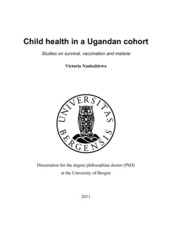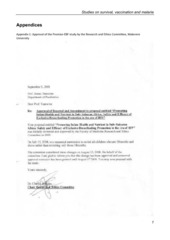| dc.description.abstract | Background: To reduce under-five mortality according to Millennium Development Goal 4, infant mortality must be reduced considerably. The aim of this thesis was to measure perinatal and infant mortality and to explore interventions (vaccination, exclusive breastfeeding (EBF) and vitamin A supplementation) that could reduce this mortality. Methods: A cluster randomized intervention trial was conducted between 2006 and 2008 in which 12 of 24 clusters, each comprising one or two villages, in Eastern Uganda were allocated to receive peer counselling for EBF. Women in their third trimester of pregnancy were recruited in all 24 clusters. A total of 835 pregnant women were followed up for pregnancy outcomes and survival of their children until their first birthday. During pregnancy, information was collected on mother’s residence, age, parity, bed net use, and whether delivery took place at home. After delivery, information was collected on vaccinations, feeding practices, growth and survival. Blood was drawn for malaria parasitaemia from 483 infants between 3 and 12 months of age. Results: The stillbirth risk was 19 [95%CI: 11, 33] per 1,000 pregnancies and the early neonatal death risk 22 [95%CI: 13, 35] per 1,000 live births. Overall, the perinatal mortality risk was 41 [95%CI: 27, 54] per 1,000 pregnancies. Perinatal mortality was 61/1,000 pregnancies among women delivering at home who, after controlling for potential confounders, had a 3.7 (95%CI: 1.8, 7.4) times higher perinatal mortality than women who gave birth in a health facility. This association was considerably stronger among nulliparous women [Risk ration (RR) 8.0 (95%CI: 2.9, 21.6)] than among women with a previous live birth [RR 1.8 (95%CI: 0.7, 4.5)]. All perinatal deaths occurred among women who did not sleep under a mosquito net. Most of the association between bed-net use and perinatal death was driven by nulliparous women. Women living in urban slums had a higher risk of losing their babies than those in rural areas [RR: 2.7 (95%CI: 1.4, 5.3)]. The infant mortality risk was 33 [95%CI: 22, 48] per 1,000 live births, neonatal mortality risk was 23 (95% CI: 14, 36) per 1,000 live births and the post-neonatal mortality risk 10 (95% CI: 4, 19) per 1,000 live births. Infants with a history of hospitalization were more likely to die compared to those that had never been hospitalized (RR: 6.4; 95%CI: 1.0, 39.7). Women with a previous child death had a higher risk of having a post-neonatal death compared to those that had never lost a child (RR: 5.8; 95%CI: 1.1, 31.7). At 24 weeks, about 51% of the infants were fully vaccinated (i.e., had received all the scheduled vaccinations: BCG, polio 0, polio 1, DPT-HB-Hib1, polio 2, DPT-HBHib 2, polio 3 and DPT-HB-Hib 3). Only 46% of the infants whose mothers’ had 5-7 years of primary education had been fully vaccinated compared to 65% of the infants whose mothers’ had some secondary education. Infants whose mothers had some secondary education were less likely to miss the DPT-HB-Hib-2 vaccine (RR: 0.5, 95% CI: 0.3, 0.8), Polio-2 (RR: 0.4, 95%CI: 0.3, 0.7), polio-3 (RR: 0.5, 95%CI: 0.4, 0.7) and DPT-HB-Hib-3 (RR: 0.5, 95%CI: 0.4, 0.7). Other factors showing some association with a reduced risk of missed vaccinations were delivery at a health facility (RR = 0.8; 95%CI: 0.7, 1.0) and use of a mosquito net (RR: 0.8; 95%CI: 0.7, 1.0). Children in intervention areas were 1.7 times as likely as children in control areas to have malaria (PR 1.7; 95% CI: 0.9, 3.0). After controlling for potential confounders, infants not supplemented with Vitamin A had a higher prevalence of malaria compared to those who had been supplemented (PR 6.1; 95% CI: 2.1, 17.6). The association between vitamin A supplementation and malaria was greatest among stunted children. Conclusion: The studies forming the basis for this thesis have shown that perinatal and infant mortality was high in Mbale, Eastern Uganda. They explored several risk factors for death and showed that they are multiple and include delivering at home and lack of bed nets especially among nulliparous women. They showed that less than adequate coverage of vaccination could be related to low maternal education, specifically low maternal secondary education. They examined two interventions that hitherto had limited evidence for reducing morbidity and malaria mortality. Whereas there was no association between EBF promotion and malaria, infants that had not been supplemented with vitamin A were more likely to have malaria parasitaemia compared to those that had been supplemented. | en_US |

